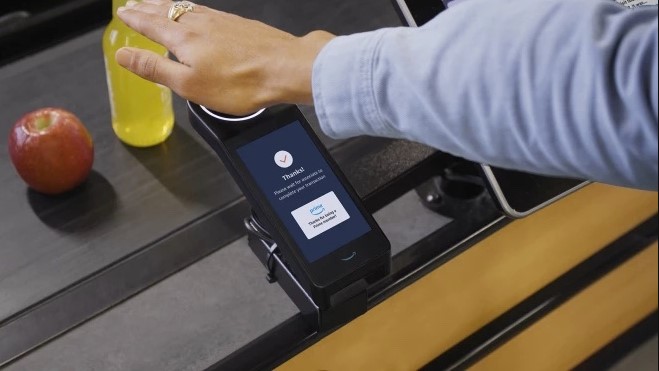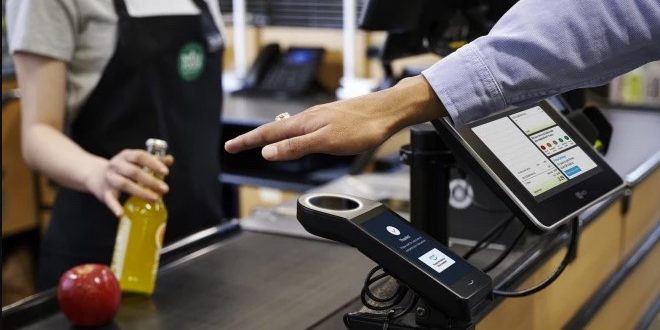Amazon One, a palm-scanning payment system, is set to expand nationwide. The retailer announced this morning that the payment tech will be in all 500+ Amazon-owned Whole Foods Market stores by year-end. Hovering a palm over a reader device activates the biometric payment system. The device then matches the customer’s palm signature to their payment card to charge them.
The retailer says Amazon One has been used over 3 million times since its 2020 launch at over 400 U.S. locations. Amazon Go convenience stores, sports stadiums, entertainment venues, and travel retailers like Hudson, CREWS, and OHM at several U.S. airports, as well as Panera Bread through a March 2023 partnership, have been among these locations.
Bridgestone Arena, Climate Pledge Arena, Globe Life Field, Lumen Field, T-Mobile Center, T-Mobile Park, NASCAR Raceway, Texas A&M Kyle Field, Hollywood Casino at Greektown in Detroit, and others use the tech.
Before today’s announcement, Whole Foods has been slowly implementing the system. Amazon One is available at over 200 Whole Foods Markets in Arizona, Arkansas, California, Colorado, Idaho, Kansas, Louisiana, Michigan, Mississippi, Missouri, Montana, Nevada, New Mexico, New York, Oklahoma, Oregon, Texas, Utah, Washington, and Wyoming. It will expand nationwide in the second half.
Amazon says shoppers can pay with their palms at Whole Foods after its expansion. Prime members who link their Amazon One profile to their Amazon account automatically receive savings.
Amazon recently announced that the reader could verify customers’ ages, allowing them to buy beer at a sports event by hovering their palm over the reader. Amazon announced in May that this system was first used at Coors Field. It’s unclear if Whole Foods will use this part of the system or require customers to show ID to store staff like most other self-checkouts.

Customers can pre-enroll online in minutes using their credit or debit card, Amazon account, and mobile number. Amazon claims partnerships with American Express, Discover, MasterCard, Visa, and other major U.S. banks. Customers enroll when they first scan their palm over the Amazon One device at a participating Whole Foods. They can also register at a store Amazon One device.
“We are always looking for new ways to delight our customers and improve the shopping experience,” said Whole Foods Market’s chief technology officer, Leandro Balbinot, about the expansion. “We’ve seen that customers love the convenience of Amazon One at Whole Foods Market stores over the past two years, and we’re excited to bring Amazon One to all of our customers across the U.S.”
Amazon claims its AWS Cloud protects customer data with multiple security measures. It also states that the palm image is a “signature” rather than a customer ID. To create a unique, numerical vector representation for identity matching, the palm and vein pattern are examined.
Amazon’s biometric payments aren’t just about reducing checkout times. The retailer can track customers online and offline using biometrics, payment card information, and Amazon accounts to serve highly personalized ads and recommendations and increase revenue.
In an earlier Amazon One FAQ, the retailer stated it “does not use or sell customer information for advertising, marketing, or any other reasons.”
Today’s FAQ states:
Amazon One will never share palm data with third parties, under any circumstance, including in response to government demands, unless we’re required to comply with a legally valid and binding order. Additionally, Amazon One is not interoperable with data provided by other sources. This is because Amazon One uses a proprietary combination of palm and vein imagery to recognize customers, making it unusable to third parties and unmatchable with data from other sources. Further, Amazon One palm data is not used by Amazon for marketing purposes, and it will not be bought by or sold to other companies for advertising, marketing, or any other reason. In fact, when you use Amazon One at third-party locations, Amazon doesn’t track what you do or buy after entering the location. That data is not associated with your biometric identity, and we built Amazon One that way intentionally.
After pressure from consumer privacy and advocacy groups, one early adopter abandoned their plans to use Amazon One’s readers. Denver Arts and Venues had planned to use Amazon One for ticketless entry at Red Rocks Amphitheater, a big win for Amazon, but it cut ties with the retailer after an open letter suggested Amazon could share palmprint data with government agencies and hackers.
After the technology’s launch in 2021, a group of U.S. senators asked Amazon about its customer biometrics plans. Amazon recently faced a class action lawsuit for failing to provide proper notice under a NYC biometric surveillance law for its Amazon One readers at Amazon Go stores.
 Tech Gadget Central Latest Tech News and Reviews
Tech Gadget Central Latest Tech News and Reviews




